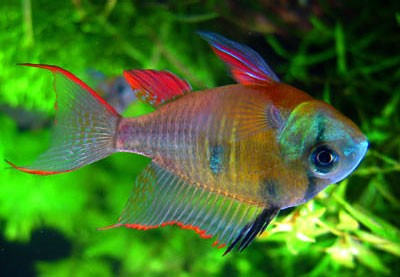The Bolivian butterfly cichlid is a very attractive aquarium fish among the freshwater pet fish keepers. It is also known as Bolivian Ram, Ruby Crown Cichlid, Hifin cichlid etc. It belongs to the family Cichlidae under order Perciformes of class Actinopterygii. In nature, it is found in Bolivia and Brazil. It prefers to live in slow flowing streams, rivers and ponds.
Systematic Position
- Phylum:Chordata
- Subphylum: Vertebrata
- Class: Actinopterygii
- Order: Cichliformes
- Family: Cichlidae
- Genus:Mikrogeophagus
- Species: Mikrogeophagus altispinosus
Physical Description
It has elongated and laterally compressed body with high dorsal fin. The body is high with a big head, big eyes which passes through almost black stripe. The body color is grayish olive to almost black. The young fish contains particularly striking colors with a spot on the side. Near head, dorsal fin rays are black in color but upper parts of other dorsal fin rays are reddish in color. At the maturing and adult stage, a narrow red stripe is present around the edges of the unpaired fins.

Bolivian Butterfly Cichlid: Mikrogeophagus altispinosus
The male is larger than females with brightly colored. The dorsal and anal fins are extended. The mature female becomes plumper when she bears eggs in her belly. The bolivian butterfly cichlid can grow up to 10 cm in length and can live up to 5 years or more.
Important Info
- Scientific name: Mikrogeophagus altispinosus
- Origin: South America (Bolivia)
- Temperament: Peaceful
- Grown up size: 10 cm
- Tank size: 30 gallons
- Tank level: Middle
- Water pH: 6.5-7.5
- Water hardness: 8.0-10.0 dGH
- Diet: Omnivore
- Breeding: egg layer
- Water temperature: 70-80 degrees F
- Care level: Moderate
- Life span: 5 years or more
Feeding
It is an omnivorous fish and it takes variety of foods which consist of aquatic insects and its larvae, different zooplankton such as Daphnia, Cyclops, Moina, Diaptomus; bloodworms, Tubifex , brine shrimp (Artemia) etc. It also accepts cichlid pellet and flake feeds. The feed should be given 2-3 times daily.
Housing
It is a peaceful fish, do not spoil the plants. It should be kept in groups or flock. To keep flocks of fish (8-10 individuals) aquarium should be 70 litters or larger. The aquarium should be planted with aquatic plants with a shelter like rock caves, large pieces of driftwood or even inverted flowerpots and free swimming space. The tank needs aeration and filtration system and 30 % of the tank water must be replaced with freshwater at weekly basis.
Breeding
It is an egg layer and it can easily breed in captive condition. It becomes sexually mature at the age between 8 and 12 months. The breeding tank should have broad leaf plants with a flower pot. The mature female prefers to spawn on perfectly clean substrate. During the breeding season, the temperature should be raised to 25-27 degrees Celsius, water hardness of 10 dGH and a pH of 6.5-7.0.
Before spawning, the parents should be conditioned with meaty food like Daphnia, Cyclops, Brine shrimps (Artemia) etc. The mature female lays up to 300 eggs. The male protects the surrounding area of the nests. Eggs develop between 60-72 hours. The larvae begin to feed on the 2-6 day. The fry should be fed with rotifers, ciliates, then nauplii, Artemia and Cyclops.
Sexing
It can easily make differentiate between the male and female. Generally, the male is larger with more brilliant colorful than the female. The male also has more pointed dorsal and caudal fin. During the breeding season, the female becomes plumper when she bears eggs on her belly.
Final Thoughts
The Bolivian Butterfly a very popular aquarium fish due to its brilliant body shape, coloration and hardiness. But it is sometimes susceptible to white spot disease due to improper tank management. To make your fish happy and healthy, the tank should be maintained properly.
You might also read: Five-banded barb
